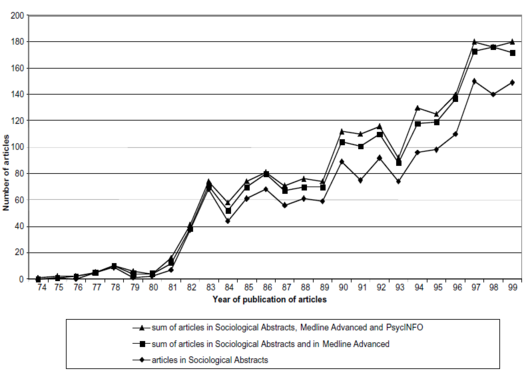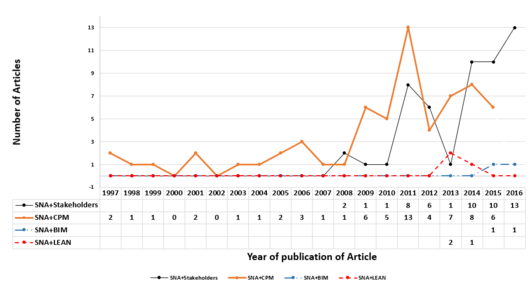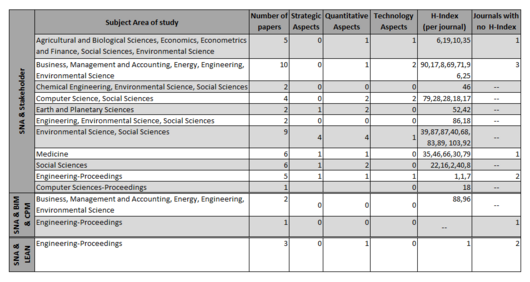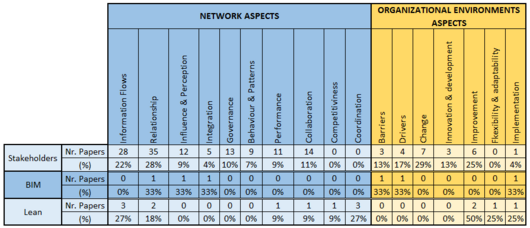Social Network Analysis-Opportunities in PPPM
Contents |
Summary
“Social Network Analysis” (SNA) appears recently as a technique that explore, maps and measure data & information flows and relationship between organizations, groups, people or other entities.
The aim of this article is to explore and investigate the existing use of “Social Network Analysis” in projects with collaborative environments, such as BIM and/or Lean Construction projects.
Stakeholders has a prominent influence in the development of any type of project, their perspective was also included in order to obtain a broad overview of the state of the art in the use of “Social Network Analysis” techniques.
The article provides an overview of the current interests and study areas, identifying research opportunities related with “Performance” and “Collaboration” aspects that have been insufficiently studied.
Introduction
Construction productivity have been a classic concern in the Building Industry, Teicholz research present a negative growth in the period 1964-2012 [1], the most likely reasons behind this situation may be the highly fragmented project workflows, procurement systems based on competitive rather than collaborative teams, paper-based project delivery systems (PDS) with a low use of technology in their processes affecting the flow of data and information between the stakeholders creating conflicts and lowering the quality of the projects along all their life cycle.
With the introduction of CPM/PERT in 1958’, the use of technology has been gradually extended in the Project Management discipline [2], but is not until the past decade when their use is being more extensive, the evolution of the technology applied in projects is transforming the Building Industry moving from a paper-based towards a BIM-based type of projects shifting to a lean collaborative processes [3] [4].
Since 2000’s it has been observed a continuous growth of complexity in projects[5][6]caused by the increasingly use of technology, project size/scale, construction methods, stakeholders diversity and overlapping processes in the life cycle of a project, as a result Project Managers have been facing an increase of challenges at strategic, organizational and human resources level[7].
Projects are team-based developed, currently, as a result of the technological advancements projects are producing an immense amount of data, sorting useful data to transform in coordinate and productive information that flows through all the processes along the life cycle of a project is crucial in their success.
Social Network Analysis(SNA)
Introduction & Historical evolution
Organizations are composed by individuals and, based in their ranks, assembled in different groups organized in a hierarchical structure. Work activities and tasks constitutes the main interaction type between these individuals establishing a formal network.
However, within the same organization, interaction between individuals could be based in their work-space proximity, nationality, sport preference, etc. in this case creating different groups and establishing an informal network.
Individuals and organizations are the main actors from either formal or informal structures and as a result of their interaction within a network (intra-organizational) or with other networks (inter-organizational), different behavior patterns and influential actors could be identified, the analysis of these network dynamics constitutes the object of study of Social Network Analysis (SNA).
According Freeman the historical evolution of SNA comprises the following periods [8][7]:
1. Everything before 1929, focused on the interaction and relationship between actors
2. From 1929 to 1939, focused in a systematic collection of data between this actors
3. From 1940 to 1969, with the introduction of graph theories
4. From 1970 until now, the modern era based on the use of mathematical/computational tools to analyse these interactions
In the past years with the birth of internet and the technological advancements, SNA gained relevance; research studies have been reformulated and reconsider their approach, being the use of network studies an important part, not only, of sociological studies but also incorporated as a strategy used by different disciplines [9][8] (Figure 1).
Organizations are open systems [10], and as individuals could be influenced by internal or external changes in the organizational environment and at the same time the interconnection between systems or individuals could be altered as a result of the above mentioned changes.
Through "Social Network Analysis" this changes and their impact in individuals and/or organizations could be studied, and depending on the network type, cohesive or bridging the effect and the propagation of the changes would be different.
The interconnection between all actors in a cohesive networks provides mutual support and trust and facilitates coordination and communication[11].
Therefore, in order to identify an asses research opportunities in the use of Social Network Analysis in collaborative environments, a review of papers and/or articles was conducted with special attention on network and organizational aspects.
Methodology
An structured approach was adopted, in the articles review:
• Search process, different iterations and combination of key words were conducted, the final retrieved articles were consequence of a refine process.
• Distribution of articles per year
• List of journals and account of articles included in each journal
• Categorization of the articles by subject area of study
• Analysis of the abstracts of the retrieved articles, identification of key words an aspects
The following common keywords were considered in the initial search, “Social Network”, “Social Network Analysis” “Stakeholder”, “BIM”, “Lean Construction”, “Engineering Systems”, “Construction Project Management”.
Search process
First iteration, through “DTU Findit” database an initial search of articles was conducted with “Social Network” and “Social Network Analysis” as keywords, the total amount of entries founded were 113.043 and 1.890 respectively.
In a first view of the searched articles it was noticed that “SNA” was used as keyword in “Social Network Analysis” articles and, in many cases, “Social Network” was referred in “Social Media” articles.
To refine the search “Social Network” was discarded.
A second iteration with the keyword “Social Network Analysis” and the operator “AND” in a successive combination with the keywords “Stakeholder”, “BIM”, “Lean Construction” was conducted, the total amount of entries founded were 2.297, 2 and 5 respectively.
It was observed that within the search “Social Network Analysis AND Stakeholder” there was still some entries referred to “Social Media”; with the search of “Social Network Analysis AND BIM” the entries corresponded with the intended search and with the search of “Social Network Analysis AND Lean Construction” there was 2 entries that corresponded with medicine subject areas.
A third iteration was conducted, the prefix “ab: abstract” and the operator “AND” were selected in the formula “ab: (SNA) AND Stakeholder”, a total 63 entries were obtained, 8 entries corresponded with repeated articles in different journals, 2 entries matched with the entries founded in the search “Social Network Analysis AND BIM” and 1 entry corresponded with one paper that reviewed the status of research SNA in construction project management context (CPM) that is coincident with the aim of this article.
Findings
Based in the combination of keywords used in the search the following papers were retrieved:
• Search area “Social Network Analysis AND Stakeholder”, 52 papers, from now on will be referred in tables or figures as “SNA + Stakeholder” or “Stakeholder”
• Search area “Social Network Analysis AND BIM”: 2 papers, from now on will be referred in tables or figures as “SNA + BIM” or “BIM”
• Search area “Social Network Analysis AND Lean Construction”: 3 papers, from now on will be referred in tables or figures as “SNA + Lean” or “Lean Construction” or “Lean”
• One paper retrieved in the search area “SNA + Stakeholder” was assigned with its own search area “Social Network Analysis and Construction Project Management”, from now on will be referred in tables and figures “SNA +CPM” or “CPM”
This paper is a review of 63 studies in a CPM context published in the period 1997-2015.
The distribution of papers by year can be seen in figure 2.
The analysis of the retrieved papers shows different aspects of interests that have been grouped in following categories:
Group 1.Publication contribution, to determine the publication that contributed the most, the amount of papers produced by every journal was accounted, a categorization by the main subject areas of study and the index of research of impact was also included [12]
Cite error:
<ref> tags exist, but no <references/> tag was found



